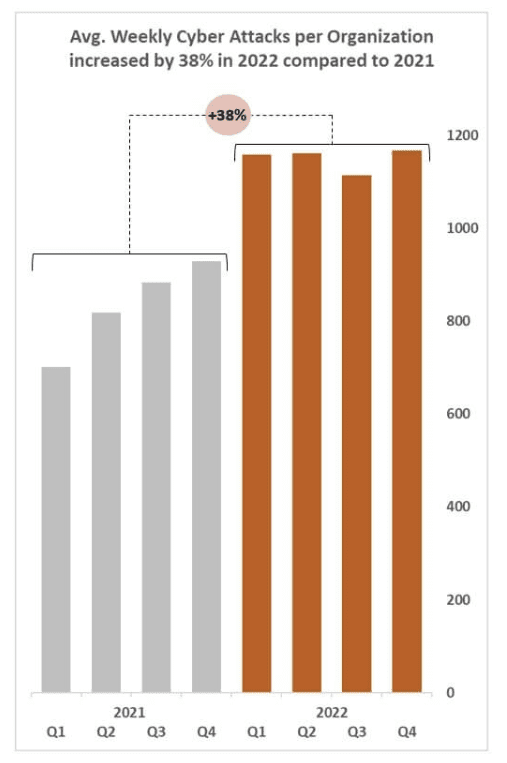In today’s digital age, cybercrime has grown to unprecedented levels. In recent years, we have seen an explosion of malicious activity across the globe as hackers deploy increasingly sophisticated tactics and technologies to penetrate organizations and access their data. The danger posed by such global cyberattacks is becoming clearer each day, with companies reporting billions in losses from stolen information and other damages. Let’s take a closer look at why global cyberattacks have become more common – and what steps you can take to prevent them in your organization.
In 2022, the world witnessed a significant rise in cyberattacks, with an increase of 38% compared to 2021, reveals a research report by Check Point. These malicious acts were largely orchestrated by smaller and more agile hacking organizations who took advantage of remote working environments made necessary due to COVID-19 safety measures. In addition, healthcare was hit especially hard – experiencing the most substantial uptick among all industries affected that year.

The number of cyberattacks around the world reached a new high in the fourth quarter of 2022. On average, there were 1168 attacks per organization each week. The region of Africa had the most attacks, with 1875 per organization each week. Asia Pacific had the second most, with 1691 attacks per organization each week.
The number of cyberattacks increased by 52% in North America, 29% in Latin America, and 26% in Europe from 2021 to 2022. In the USA, the number of cyberattacks increased by 57%. The UK witnessed an increase of 77% in the number of cyberattacks and Singapore saw a 26% increase in the number of cyberattacks.
Reasons behind the rising cyberattacks
- Over the past year, cybercriminals have been quick to recognize and exploit the opportunities that emerged with the rise of remote work and the rapid digital transformation of many organizations.
- To begin with, the ransomware ecosystem has become more complex, as criminal groups break off into smaller units to evade law enforcement attempts.
- Furthermore, attackers are broadening their scope by targeting collaboration tools like Slack, Teams, OneDrive, and Google Drive through phishing scams.
- On top of this, academic institutions have recently experienced increased threats due to their swift move to digital modes of learning.
Due to these heightened security risks across sectors, there has been a rise in cyber incidents.
The healthcare industry in the US saw an 86% rise in cyberattacks
The US healthcare sector experienced a staggering 86% increase in malicious cyber incidents from 2021 to 2022, coming second only to the overall number of recorded attacks across all industries. On average, hospitals and other medical facilities endured 1410 weekly strikes.
The healthcare sector is a prime target for cybercriminals due to the wealth of valuable data held within. With the potential for personal health insurance information, medical records numbers, and even social security data available through these institutions—not to mention ransom demands posed directly at patients—the healthcare sector is seen as particularly lucrative by malicious cybercriminals aiming not only for financial gain but also notoriety among their peers.
Education institutions around the world saw a sharp rise in cyberattacks in 2022, with an average of 2,314 instances per organization every week. This was fuelled by their unanticipated transition to digital learning environments which were ill-equipped for such threats and provided hackers easy access points due to students using personal devices, working from shared locations, or connecting on public WiFi without regard for security measures.
What you can do to prevent cyberattacks
Provide cyber awareness training in organizations
To prevent the devastating effects of ransomware, employees must be educated in proper cybersecurity awareness. These practices include avoiding suspicious links and attachments; exercising caution with personal information when communicating outside the organization; authenticating software before downloading it; not using foreign USBs on work computers, as well as accessing public Wi-Fi networks through a virtual private network (VPN).
Encrypt and backup your data
It’s critical to safeguard sensitive data by encrypting it. This ensures the information is only accessible with an encryption key and prevents unauthorized parties from reading or tampering with the content. Additionally, ensure protection against unforeseen events by regularly backing up your data so that any potential losses will not be catastrophic for business operations and revenue generation.
Implement a patch management strategy
To defend against cyber threats such as ransomware, businesses should make sure to maintain their technology systems by regularly installing security patches and updates. These tasks are especially important for any software with a “critical” label – necessary precautions that can help organizations reduce the risk of attack.
However, vigilance is still key. Organizations should implement a patch management strategy that ensures all team members operate with updated versions for maximum protection against malicious actors.
Use a comprehensive cyber protection software
Proactive protection has become more important than ever before. Rather than relying solely on reactive solutions, investing in proactive cyber protection technologies provides a powerful way of blocking malicious attack attempts and stopping advanced threats such as zero-day exploits and unknown malware at the source, thereby minimizing disruption to your organization’s operations.
Read next: Veeam report highlights what IT leaders must know about cloud protection in 2023








